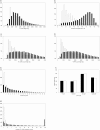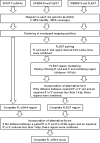Gene organization in rice revealed by full-length cDNA mapping and gene expression analysis through microarray
- PMID: 18043742
- PMCID: PMC2084198
- DOI: 10.1371/journal.pone.0001235
Gene organization in rice revealed by full-length cDNA mapping and gene expression analysis through microarray
Abstract
Rice (Oryza sativa L.) is a model organism for the functional genomics of monocotyledonous plants since the genome size is considerably smaller than those of other monocotyledonous plants. Although highly accurate genome sequences of indica and japonica rice are available, additional resources such as full-length complementary DNA (FL-cDNA) sequences are also indispensable for comprehensive analyses of gene structure and function. We cross-referenced 28.5K individual loci in the rice genome defined by mapping of 578K FL-cDNA clones with the 56K loci predicted in the TIGR genome assembly. Based on the annotation status and the presence of corresponding cDNA clones, genes were classified into 23K annotated expressed (AE) genes, 33K annotated non-expressed (ANE) genes, and 5.5K non-annotated expressed (NAE) genes. We developed a 60mer oligo-array for analysis of gene expression from each locus. Analysis of gene structures and expression levels revealed that the general features of gene structure and expression of NAE and ANE genes were considerably different from those of AE genes. The results also suggested that the cloning efficiency of rice FL-cDNA is associated with the transcription activity of the corresponding genetic locus, although other factors may also have an effect. Comparison of the coverage of FL-cDNA among gene families suggested that FL-cDNA from genes encoding rice- or eukaryote-specific domains, and those involved in regulatory functions were difficult to produce in bacterial cells. Collectively, these results indicate that rice genes can be divided into distinct groups based on transcription activity and gene structure, and that the coverage bias of FL-cDNA clones exists due to the incompatibility of certain eukaryotic genes in bacteria.
Conflict of interest statement
Figures


Similar articles
-
Collection and comparative analysis of 1888 full-length cDNAs from wild rice Oryza rufipogon Griff. W1943.DNA Res. 2008 Oct;15(5):285-95. doi: 10.1093/dnares/dsn018. Epub 2008 Aug 6. DNA Res. 2008. PMID: 18687674 Free PMC article.
-
Assessment of adaptive evolution between wheat and rice as deduced from full-length common wheat cDNA sequence data and expression patterns.BMC Genomics. 2009 Jun 18;10:271. doi: 10.1186/1471-2164-10-271. BMC Genomics. 2009. PMID: 19534823 Free PMC article.
-
RICD: a rice indica cDNA database resource for rice functional genomics.BMC Plant Biol. 2008 Nov 26;8:118. doi: 10.1186/1471-2229-8-118. BMC Plant Biol. 2008. PMID: 19036133 Free PMC article.
-
High-throughput analysis of rice genes by means of the heterologous full-length cDNA overexpressor (FOX)-hunting system.Int J Dev Biol. 2013;57(6-8):517-23. doi: 10.1387/ijdb.130176mm. Int J Dev Biol. 2013. PMID: 24166434 Review.
-
RIKEN Arabidopsis full-length (RAFL) cDNA and its applications for expression profiling under abiotic stress conditions.J Exp Bot. 2004 Jan;55(395):213-23. doi: 10.1093/jxb/erh007. Epub 2003 Dec 12. J Exp Bot. 2004. PMID: 14673034 Review.
Cited by
-
High-resolution mapping of open chromatin in the rice genome.Genome Res. 2012 Jan;22(1):151-62. doi: 10.1101/gr.131342.111. Epub 2011 Nov 22. Genome Res. 2012. PMID: 22110044 Free PMC article.
-
Melatonin-Regulated Chaperone Binding Protein Plays a Key Role in Cadmium Stress Tolerance in Rice, Revealed by the Functional Characterization of a Novel Serotonin N-Acetyltransferase 3 (SNAT3) in Rice.Int J Mol Sci. 2024 May 29;25(11):5952. doi: 10.3390/ijms25115952. Int J Mol Sci. 2024. PMID: 38892140 Free PMC article.
-
Characterization of the rice PHO1 gene family reveals a key role for OsPHO1;2 in phosphate homeostasis and the evolution of a distinct clade in dicotyledons.Plant Physiol. 2010 Mar;152(3):1693-704. doi: 10.1104/pp.109.149872. Epub 2010 Jan 15. Plant Physiol. 2010. PMID: 20081045 Free PMC article.
-
Application of resequencing to rice genomics, functional genomics and evolutionary analysis.Rice (N Y). 2014 Jul 8;7(1):4. doi: 10.1186/s12284-014-0004-7. eCollection 2014. Rice (N Y). 2014. PMID: 25006357 Free PMC article. Review.
-
Multifunctionality and diversity of GDSL esterase/lipase gene family in rice (Oryza sativa L. japonica) genome: new insights from bioinformatics analysis.BMC Genomics. 2012 Jul 15;13:309. doi: 10.1186/1471-2164-13-309. BMC Genomics. 2012. PMID: 22793791 Free PMC article.
References
-
- Goff SA, Ricke D, Lan TH, Presting G, Wang R, Dunn M, et al. A draft sequence of the rice genome (Oryza sativa L. ssp. japonica). Science. 2002;296:92–100. - PubMed
-
- Yu J, Hu S, Wang J, Wong GK, Li S, et al. A draft sequence of the rice genome (Oryza sativa L. ssp. indica). Science. 2002;296:79–92. - PubMed
-
- Yu J, Wang J, Lin W, Li S, Li H, et al. PLoS Biol 3. 2005. The genomes of Oryza sativa: a history of duplications. Available: http://biology.plosjournals.org/perlserv/requestget-documentdoi10.1371/j... Accessed 1 Feb 2005. - PMC - PubMed
-
- International Rice Genome Sequencing Project. The map-based sequence of the rice genome. Nature. 2005;436:793–800. - PubMed
-
- Rice Full-Length cDNA Consortium. Collection, mapping, and annotation of over 28,000 cDNA clones from japonica rice. Science. 2003;301:376–379. - PubMed
Publication types
MeSH terms
Substances
LinkOut - more resources
Full Text Sources
Other Literature Sources
Molecular Biology Databases

